![]()
![]()
![]()
Use LEFT and RIGHT arrow keys to navigate between flashcards;
Use UP and DOWN arrow keys to flip the card;
H to show hint;
A reads text to speech;
23 Cards in this Set
- Front
- Back
|
A sudden, violent dislocation in the subsurface caused by stress buildup on a fault. |
Earthquakes! |
|
|
Earthquake physics |
- tectonic forces build up gradually, increasing stresses in crustal blocks - when tectonic stresses become too large for crustal rocks to sustain, a sudden rupture of the crustal block occurs and the crust rebounds to a new equilibrium position - Eq is the sudden slip on a fault - energy is released in waves and causes the energy that we feel at the surface |
|
|
Time Sequence of Elastic Rebound Theory |
1. Before EQ: stress in crustal block slowly accumulates by tectonic forces. 2. During EQ: stress released by motion on a new or pre-existing rupture or fracture zone (called a fault) 3. Immediately after EQ: crust rebounds to an unstressed equilibrium position 4. Following equilibrium, stress begins to reaccumulate slowly! |
|
|
Elastic Rebound Theory: Before, After the Earthquake |
After EQ: EQ occurs and the fence (lithospheric) distortion is released. Two parts of the fence are again straight, but with an offset Before EQ: As the pacific plate moves northwest, it gradually distorts the fence. Just before EQ, fence has an 'S" shape At Start: Fence straddles san Andreas fault (fence is photograph taken of san francisco earthquake) |
|
|
Henry Fielding Reid |
Elastic Rebound Theory |
|
|
Faults |
- fracture (rupture) or zone of fractures between two blocks of rock - allow the blocks to move relative to each other - movement may occur rapidly or slowly - can range in length for a few mm to thousands of km - produce repeated displacements over geologic time |
|
|
Creep |
when fault blocks move slowly |
|
|
Strike-Slip Faults |

occur where one plate slides horizontally past another plate - all transform faults are strike slip faults, but not all strike slip faults are transform faults! |
|
|
Thrust (reverse) faults |
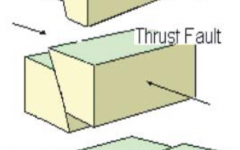
- Largest occur at subduction zones, where one plate rides under/above a second plate (e.g. Cascadia, Japan) - potentially the largest events - occurs where plates are pushing together under compression - convergent plate boundary - can also occur at the boundary between converging continental or oceanic lithosphere |
|
|
Normal faults |
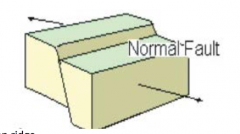
- tends to occur in tensional regimes, as seen in continental rifting - occurs when plates are pulling apart under tension - divergent plate boundary |
|
|
Benioff-Wadati Zone |
Dipping (subduction zone) of EQs are found as deep as 660 km in the mantle - stresses that occur from pushing the plate deep within the mantle cause earthquakes over subduction zones - the depth depends on the thermal conductivity of the material - dictated by pressure and temperature |
|
|
Seismic Intensity Map |
A map that shows the intensity of the seismic waves |
|
|
Glacial Isostatic Readjustment |
The readjustment of the lithosphere to the original positioning after depression from glaciers-can cause earthquakes |
|
|
Fault |
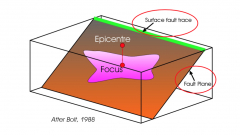
A surface (often a plane) across which two blocks can move relative to each other |
|
|
Focus (or hypocenter) |
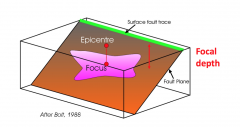
The location on a fault where the earthquake rupture initiates |
|
|
Hypocentre |

The calculated position of an earthquake's focus |
|
|
Epicentre |
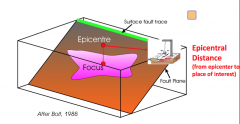
The point on Earth's surface directly above the hypocenter |
|
|
P Waves |
Primary (compressional) wave |
|
|
S Waves |
Secondary (shear) waves |
|
|
Rayleigh waves |
Circular motion surface wave; slow |
|
|
Love waves |
Slow side by side motion |
|
|
Zhang Heng |
Invented first seismometer in first century AD - dragon frog thing |
|
|
Pendulum seismographs |
invented mid 1700s |

